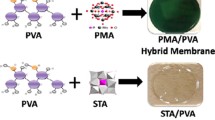Abstract
Bioethanol is used widely as a solvent and is considered a potential liquid fuel. Ethanol can be produced from biomass by fermentation, which results in low concentrations of alcohol in water. Conventional distillation is normally used to separate ethanol from water, but it required high energy consumption. Therefore, alternative approaches to this separation are being pursued. This study examined the potential use of poly(ionic liquid)s (PILs) for the extraction and separation of alcohols from the aqueous phase. Hydrophobic PILs were developed and evaluated by the adsorption of ethanol from ethanol/water solutions. All the necessary parameters, such as cations and anions of the ionic liquid, morphology of the polymer and processing conditions, were evaluated.








Similar content being viewed by others
References
Quintero JA, Montoy MI, Sánchez OJ, Giraldo OH, Cardona CA (2008) Fuel ethanol production from sugarcane and corn: comparative analysis for a Colombian case. Energy 33:385–399
Gnansounou E, Dauriat A (2010) Techno-economic analysis of lignocellulosic ethanol: a review. Bioresour Technol 101:4980–4991
Bridgwater AV (1995) The technical and economic feasibility of biomass gasification for power generation. Fuel 74:631–653
Qureshi N, Hughes S, Maddox IS, Cotta MA (2005) Energy-efficient recovery of butanol from model solutions and fermentation broth by adsorption. Bioprocess Biosyst Eng 27:215–222
Huang HJ, Ramaswamy S, Tschirner UW, Ramarao BV (2008) A review of separation technologies in current and future biorefineries. Sep Purif Technol 62:1–21
Vane LM (2008) Separation technologies for the recovery and dehydration of alcohols from fermentation broths. Biofuels, Bioprod Biorefin 2:553–588
Vane LM (2005) A review of pervaporation for product recovery from biomass fermentation processes. J Chem Technol Biotechnol 80:603–629
Thomas W (1999) Room temperature ionic liquids: solvents for synthesis and catalysis. Chem Rev 99:2071–2084
Brennecke JF, Maginn EJ (2001) Ionic liquids: innovative fluids for chemical processing. AIChE J 47:2384–2389
Seddon KR (1996) Room-temperature ionic liquids: neoteric solvents for clean catalysis. Kinet Catal 37:693–697
Boudreau TM, Hill GA (2006) Improved ethanol–water separation using fatty acids. Process Biochem 41:980–983
Fadeev AG, Meagher MM (2001) Opportunities for ionic liquids in recovery of biofuels. Chem Commun 3:295–296
Chapeaux A, Simoni LD, Ronan TS, Stadtherr MA, Brennecke JF (2008) Extraction of alcohols from water with 1-hexyl-3-methylimidazolium bis(trifluoromethylsulfonyl)imide. Green Chem 10:1301–1306
Neves CMSS, Granjo JFO, Freire MG, Robertson A, Oliveira NMC, Coutinho JAP (2011) Separation of ethanol–water mixtures by liquid–liquid extraction using phosphonium-based ionic liquids. Green Chem 13:1517–1526
Yuan J, Antonietti M (2011) Poly(ionic liquid) latexes prepared by dispersion polymerization of ionic liquid monomers. Macromolecules 44:744–750
Bi W, Tian M, Row KH (2012) Separation of phenolic acids from natural plant extracts using molecularly imprinted anion-exchange polymer confined ionic liquids. J Chromatogr A 1232:37–42
Qiu H, Sawada T, Jiang S, Ihara H (2010) Synthesis and characterization of poly(ionic liquid)-grafted silica hybrid materials through surface radical chain-transfer polymerization and aqueous anion-exchange. Mater Lett 64:1653–1655
Al-bishri HM, Abdel-Fattah TM, Mahmoud ME (2012) Immobilization of [Bmim + Tf2 N −] hydrophobic ionic liquid on nano-silica-amine sorbent for implementation in solid phase extraction and removal of lead. J Ind Eng Chem. doi:10.1016/j.jiec.2012.01.018
Huddleston JG, Visser AE, Reichert WM, Willauer HD, Broker GA, Rogers RD (2001) Characterization and comparison of hydrophilic and hydrophobic room temperature ionic liquids incorporating the imidazolium cation. Green Chem 3:156–164
Bi W, Tian M, Row KH (2012) Selective extraction and separation of oxymatrine from Sophora flavescens Ait. extract by silica-confined ionic liquid. J Chromatogr B 880:108–113
Acknowledgments
This research was supported by Basic Science Research Program through the National Research Foundation (NRF) of Korea funded by the Ministry of Education, Science and Technology (2012-0005250).
Author information
Authors and Affiliations
Corresponding author
Rights and permissions
About this article
Cite this article
Bi, W., Tang, B. & Row, K.H. Adsorption of alcohol from water by poly(ionic liquid)s. Bioprocess Biosyst Eng 36, 651–658 (2013). https://doi.org/10.1007/s00449-012-0828-8
Received:
Accepted:
Published:
Issue Date:
DOI: https://doi.org/10.1007/s00449-012-0828-8



